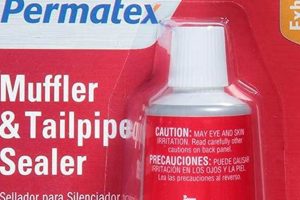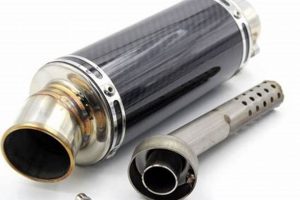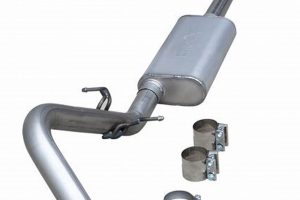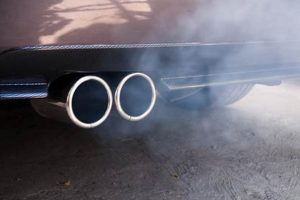These components are integral parts of vehicle exhaust systems, primarily designed to reduce the noise generated by the engine’s combustion process. These devices utilize chambers and tubes engineered to reflect and absorb sound waves, thereby diminishing their amplitude before they are released into the atmosphere. They are generally constructed from materials such as aluminized steel or stainless steel to withstand the high temperatures and corrosive gases present in exhaust streams.
The effectiveness of these units contributes significantly to environmental noise reduction, enhancing the quality of life in urban areas and minimizing the impact on sensitive ecosystems. Their development and implementation have been driven by increasingly stringent regulations regarding noise pollution from vehicles. Furthermore, properly functioning units optimize engine performance by ensuring efficient exhaust flow, contributing to improved fuel economy and reduced emissions.
The subsequent sections of this discussion will delve into the selection criteria, maintenance practices, and potential performance upgrades related to these essential automotive parts. We will also examine common issues and troubleshooting techniques, providing a complete overview of their role in maintaining a vehicle’s operational integrity and environmental compliance.
Essential Guidelines for Exhaust System Maintenance
Maintaining the integrity of exhaust noise reduction devices is crucial for vehicle performance, regulatory compliance, and environmental responsibility. Adhering to these guidelines can prolong the lifespan and efficiency of these components.
Tip 1: Regular Visual Inspection: Conduct routine inspections of the unit for signs of corrosion, physical damage, or leaks. Address minor issues promptly to prevent escalation into more significant problems.
Tip 2: Prompt Leak Repair: Exhaust leaks not only increase noise pollution but can also allow dangerous gases to enter the vehicle’s cabin. Address any leaks immediately by replacing damaged gaskets or sections of piping.
Tip 3: Avoid Short Trips: Frequent short trips do not allow the exhaust system to reach optimal operating temperature, leading to moisture buildup and accelerated corrosion. When possible, incorporate longer drives to facilitate complete evaporation of accumulated moisture.
Tip 4: Monitor Engine Performance: Changes in engine performance, such as reduced power or decreased fuel efficiency, can indicate exhaust system problems. Investigate potential issues promptly to avoid further damage.
Tip 5: Professional Inspection: Schedule periodic professional inspections of the entire exhaust system, including the noise reduction device, to identify potential issues that may not be readily apparent during visual inspection.
Tip 6: Proper Mounting Hardware: Ensure that all mounting hardware, including hangers and brackets, are securely fastened and in good condition. Damaged or missing hardware can cause excessive stress on the exhaust system, leading to premature failure.
Tip 7: Consider Material Upgrades: When replacing an existing unit, consider upgrading to a more durable material, such as stainless steel, to increase resistance to corrosion and extend service life.
By diligently following these guidelines, vehicle owners can ensure the continued efficient operation of exhaust systems, contributing to reduced noise pollution, improved engine performance, and enhanced vehicle longevity.
The subsequent section will address common troubleshooting scenarios and explore options for optimizing exhaust system performance beyond basic maintenance.
1. Noise Reduction
The fundamental purpose of exhaust systems centers on attenuating the intense acoustic energy produced by internal combustion engines. These components are specifically engineered to diminish the amplitude of sound waves propagating through the exhaust stream, thus minimizing environmental noise pollution.
- Internal Chamber Design
The configuration of internal chambers within the component significantly affects its noise-reduction capability. Baffles, resonators, and strategically placed perforations disrupt and cancel out sound waves of varying frequencies. A complex chamber design can attenuate a wider range of frequencies, resulting in a quieter exhaust note.
- Sound Absorption Materials
The incorporation of sound-absorbing materials, such as fiberglass packing or specialized acoustic insulation, further enhances noise reduction. These materials convert acoustic energy into heat through friction, effectively dampening sound waves as they pass through the component.
- Exhaust Flow Optimization
An efficient design balances noise reduction with minimal restriction of exhaust flow. Excessive backpressure can negatively impact engine performance and fuel economy. Therefore, internal structures must effectively attenuate sound without impeding the passage of exhaust gases.
- Material Selection and Construction
The material composition and construction techniques influence the component’s ability to withstand high temperatures, corrosive gases, and mechanical vibrations. Robust construction, coupled with corrosion-resistant materials, ensures long-term noise-reduction effectiveness and prevents premature failure due to environmental degradation.
The integration of these factors enables the component to achieve optimal noise reduction while maintaining engine performance and durability. Deviations from these design principles can compromise the effectiveness and longevity of the system. A well-designed component represents a careful balance of acoustic engineering and material science, resulting in a quieter, more efficient, and more environmentally responsible vehicle.
2. Exhaust Flow
Exhaust flow, measured as the volume of exhaust gases expelled from an engine over time, significantly affects the overall performance and efficiency. The internal design of the device is crucial in determining the rate at which these gases are expelled. Restrictions within the component impede exhaust flow, leading to increased backpressure and potentially diminished engine output.
- Internal Diameter and Pipe Configuration
The internal diameter of the pipes within the component directly affects exhaust flow. Larger diameters reduce flow restriction, facilitating smoother passage of gases. Complex pipe configurations involving sharp bends or constrictions impede flow, increasing backpressure. The optimal configuration balances flow efficiency with noise reduction requirements. For instance, performance vehicles often prioritize larger diameter pipes to maximize engine power, while sacrificing some degree of noise suppression. The selection of an appropriately sized component based on engine displacement and performance targets is essential.
- Baffle Design and Placement
Baffles are internal partitions designed to disrupt sound waves and reduce noise levels. However, improperly designed or positioned baffles can create significant flow restrictions. The number, size, and orientation of baffles within the component must be carefully engineered to minimize backpressure while effectively attenuating sound. A balance between noise reduction and exhaust flow efficiency is achieved through precise baffle design and strategic placement. Performance components often utilize perforated baffles or strategically spaced chambers to optimize exhaust flow.
- Surface Roughness and Material Composition
The internal surface roughness of the device impacts exhaust flow. Rough surfaces generate turbulence, increasing flow resistance. Smoother internal surfaces facilitate laminar flow, minimizing pressure drop and enhancing exhaust velocity. The material composition of the component, such as stainless steel or aluminized steel, influences surface roughness and corrosion resistance. Stainless steel typically exhibits smoother internal surfaces and superior corrosion resistance compared to aluminized steel, contributing to improved exhaust flow characteristics over the component’s lifespan.
In conclusion, the design and construction of exhaust noise reduction components are critical to ensuring efficient exhaust flow, impacting engine performance and fuel economy. The internal diameter, baffle design, and material composition of the device all contribute to the overall flow characteristics. A well-designed component strikes a balance between noise reduction and exhaust flow efficiency, optimizing vehicle performance and minimizing environmental impact.
3. Material Durability
Material durability, concerning components intended for exhaust systems, dictates the operational lifespan and sustained performance of said components, particularly in harsh operating conditions. The selected materials must resist degradation caused by high temperatures, corrosive exhaust gases, and mechanical stresses.
- Corrosion Resistance of Base Metals
The base metal’s inherent resistance to corrosion is paramount. Stainless steel alloys, such as 304 or 409, are favored due to their chromium content, forming a passive oxide layer that inhibits rust formation. Aluminized steel offers a lower-cost alternative, providing a sacrificial layer of aluminum that corrodes before the underlying steel. However, aluminized steel offers inferior long-term protection compared to stainless steel, particularly in regions with road salt exposure.
- Weld Integrity and Fatigue Resistance
Weld joints are often the weakest points in exhaust systems. Poorly executed welds are susceptible to corrosion and cracking under thermal cycling and vibration. Proper welding techniques, such as Gas Tungsten Arc Welding (GTAW), ensure strong, corrosion-resistant joints that withstand fatigue. Furthermore, the selection of appropriate filler metals that match the base metal’s composition is crucial in preventing galvanic corrosion at the weld interface.
- Coating and Surface Treatments
Protective coatings, such as ceramic coatings or high-temperature paints, extend the lifespan of components constructed from less corrosion-resistant materials. These coatings create a barrier against exhaust gases and environmental elements, slowing down the corrosion process. Surface treatments, such as phosphate coating or black oxide, improve corrosion resistance and provide a visually appealing finish.
- Thickness and Gauge of Material
The thickness of the material contributes directly to its structural integrity and resistance to mechanical damage. Thicker gauge materials, such as 16-gauge versus 20-gauge steel, offer superior resistance to denting, bending, and cracking. However, increased thickness adds weight and cost to the component. The optimal gauge is chosen based on the intended application and the balance between durability and weight considerations.
Therefore, the long-term performance and reliability are directly influenced by the choice of materials and construction methods. Selecting high-quality, corrosion-resistant materials and employing robust manufacturing processes are essential for ensuring the longevity and effectiveness in demanding automotive environments.
4. Corrosion Resistance
The longevity and operational effectiveness of components designed for noise reduction within vehicle exhaust systems are intrinsically linked to their corrosion resistance. Exhaust gases, byproducts of the combustion process, contain corrosive elements, including water vapor, sulfur oxides, and nitrogen oxides. These substances, in combination with elevated operating temperatures, create a harsh environment conducive to accelerated corrosion. Insufficient corrosion resistance leads to material degradation, structural weakening, and eventual failure of the component.
Material selection is a primary determinant of corrosion resistance. Stainless steel alloys, such as 304 and 409, are commonly employed due to their inherent chromium content, which forms a passive oxide layer, hindering rust formation. Aluminized steel provides a more economical alternative, offering a sacrificial layer of aluminum that corrodes preferentially, protecting the underlying steel. However, the protective capabilities of aluminized steel are limited compared to stainless steel, particularly in regions where road de-icing salts are prevalent. The consequences of inadequate corrosion resistance are multifaceted: increased noise emissions due to exhaust leaks, reduced engine performance resulting from backpressure alterations, and the potential release of harmful exhaust gases into the atmosphere. Regular inspection and maintenance, including the application of protective coatings, mitigate corrosion and extend the component’s lifespan.
Effective corrosion resistance in exhaust noise reduction components is not merely a matter of material selection, but a crucial element in ensuring vehicle longevity, regulatory compliance, and environmental responsibility. Understanding the mechanisms of corrosion and implementing appropriate preventative measures are essential for maintaining the performance and integrity of vehicle exhaust systems. The economic and environmental implications of premature failure underscore the importance of prioritizing corrosion resistance in design, manufacturing, and maintenance practices.
5. Installation Integrity
The operational effectiveness and longevity of exhaust noise reduction components are inextricably linked to the integrity of their installation. A poorly installed component compromises not only its intended function but also the performance and safety of the vehicle.
- Secure Mounting and Support
Proper mounting is essential to prevent excessive vibration and stress on the component and its connecting pipes. Secure hangers and brackets, correctly positioned and tightened, distribute the component’s weight evenly and absorb engine vibrations. Insufficient support leads to premature cracking, leaks, and eventual failure due to metal fatigue. Examples of inadequate mounting include using incorrect or missing hangers, failing to tighten mounting hardware adequately, or neglecting to replace deteriorated rubber isolators.
- Leak-Free Connections
The connections between the component and the exhaust pipes must be airtight to prevent exhaust leaks. Leaks diminish noise reduction effectiveness, reduce engine performance, and allow dangerous exhaust gases to enter the vehicle’s cabin. Ensuring leak-free connections involves using new gaskets or seals, properly aligning the component with the exhaust pipes, and tightening all fasteners to the manufacturer’s specified torque. Instances of improper connections include reusing old or damaged gaskets, overtightening fasteners, which can damage the flange surfaces, and neglecting to properly align the exhaust pipes before tightening connections.
- Proper Alignment and Clearance
The component must be properly aligned within the vehicle’s undercarriage to avoid contact with other components or the vehicle’s body. Contact can generate unwanted noise, cause damage to the component or surrounding parts, and potentially create a fire hazard. Adequate clearance ensures proper airflow around the component, preventing overheating and prolonging its lifespan. Misalignment scenarios include installing the component at an incorrect angle, failing to account for suspension travel, and neglecting to secure wiring harnesses or brake lines that may come into contact with the hot exhaust components.
- Correct Component Selection
Utilizing the incorrect component, or a substandard alternative, can cause installation problems and compromise performance. This may manifest as physical fitment issues, or incompatibility with factory connection locations. Choosing a noise reduction component that does not match the vehicle’s specifications leads to reduced noise reduction, potential engine damage due to excessive backpressure, and difficulty in maintaining regulatory compliance. Examples include using components designed for a different vehicle model, installing undersized components that restrict exhaust flow, and substituting low-quality aftermarket components that do not meet original equipment manufacturer (OEM) standards.
In summary, meticulous attention to installation details is crucial to maximizing the benefits and ensuring the long-term reliability of exhaust noise reduction components. Proper mounting, leak-free connections, correct alignment, and proper component selection are essential for optimizing performance, preventing damage, and ensuring vehicle safety and regulatory compliance. Neglecting these aspects compromises the component’s effectiveness and poses significant risks to vehicle integrity and occupant safety.
6. Emission Control
Regulation of exhaust emissions constitutes a significant aspect of vehicle design and maintenance. Exhaust noise reduction components, while primarily intended to attenuate sound, can indirectly influence a vehicle’s ability to meet increasingly stringent emissions standards. The connection between these components and overall emission control performance warrants careful consideration.
- Backpressure and Catalytic Converter Efficiency
The design influences exhaust backpressure, which, in turn, impacts the catalytic converter’s operational efficiency. Excessive backpressure hinders exhaust flow, reducing the converter’s ability to oxidize pollutants such as hydrocarbons, carbon monoxide, and nitrogen oxides. Conversely, insufficient backpressure can result in suboptimal converter temperatures, also diminishing its effectiveness. Consequently, the design must strike a balance to ensure optimal catalytic converter performance.
- Leak Mitigation and Greenhouse Gas Reduction
A properly functioning exhaust noise reduction component is essential for maintaining a leak-free exhaust system. Exhaust leaks not only increase noise pollution but also contribute to the release of uncombusted hydrocarbons and other pollutants into the atmosphere. These emissions contribute to smog formation and greenhouse gas accumulation. Therefore, a well-sealed exhaust system, facilitated by a properly installed and maintained component, reduces overall emissions and contributes to environmental stewardship.
- Material Composition and Pollutant Reactivity
The materials used in the construction of can influence their reactivity with exhaust gases. Certain materials, particularly those containing catalytic elements, may inadvertently contribute to the formation of undesirable pollutants. Therefore, material selection must consider not only durability and corrosion resistance but also potential interactions with exhaust gas constituents. In some instances, specifically designed catalysts may be incorporated into to enhance the reduction of harmful emissions.
- Regulation and Compliance
Vehicle emission standards are regulated by governmental agencies, such as the Environmental Protection Agency (EPA) in the United States. Non-compliance with these standards results in penalties and can impact a vehicle’s legality for operation. Therefore, selecting a component that does not adversely affect emissions control systems is crucial for maintaining regulatory compliance. Tampering with or removing emissions control devices is illegal and carries significant consequences.
In summary, the selection and maintenance of exhaust noise reduction components have indirect but significant implications for vehicle emission control. Considerations of backpressure, leak prevention, material composition, and regulatory compliance are essential for ensuring optimal environmental performance and avoiding legal repercussions. These factors should be carefully evaluated when choosing, installing, or modifying exhaust system components.
7. Component Longevity
The extended lifespan of vehicular exhaust components significantly impacts operational costs, environmental burden, and overall vehicle reliability. Factors influencing the durability directly affect the frequency of replacements and associated maintenance expenses. Understanding these factors is crucial for informed decision-making regarding product selection and maintenance practices.
- Material Composition and Resistance to Corrosion
The constituent materials directly influence susceptibility to corrosion from exhaust gases, road salts, and environmental conditions. Stainless steel alloys generally exhibit superior corrosion resistance compared to aluminized steel, resulting in prolonged service life. The choice of material significantly impacts the rate of degradation and, consequently, the component’s operational lifespan. Premature corrosion compromises structural integrity, leading to leaks and diminished noise reduction efficiency.
- Weld Quality and Structural Integrity
Welded joints represent potential points of failure, particularly under conditions of thermal cycling and vibration. High-quality welds that exhibit resistance to cracking and fatigue are essential for maintaining structural integrity over extended periods. Inferior weld quality accelerates degradation, potentially leading to premature component failure and requiring costly repairs or replacements. Proper welding techniques and the use of appropriate filler materials are critical for maximizing longevity.
- Exposure to Extreme Temperatures and Thermal Cycling
The fluctuating temperature environment within an exhaust system imposes significant stress on component materials. Repeated heating and cooling cycles induce thermal expansion and contraction, potentially leading to fatigue and cracking. Materials with high thermal fatigue resistance are better suited to withstand these stresses, ensuring a prolonged lifespan. Effective heat shielding and proper insulation minimize temperature fluctuations, contributing to increased durability.
- Impact of Road Debris and Physical Damage
Exposure to road debris, such as rocks and other foreign objects, poses a risk of physical damage that can compromise structural integrity. Components constructed from thicker gauge materials exhibit greater resistance to physical impacts and are less susceptible to damage that accelerates corrosion or induces structural failure. Strategic placement of shielding and guards can mitigate the risk of damage from road debris, contributing to increased component longevity.
Consideration of these factors is paramount in assessing the overall value proposition of exhaust noise reduction components. While initial cost may be a primary concern, evaluating material composition, weld quality, resistance to thermal stress, and protection against physical damage provides a more comprehensive understanding of potential long-term costs and performance. Informed decisions based on these factors contribute to reduced maintenance expenses, enhanced vehicle reliability, and minimized environmental impact over the vehicle’s operational lifespan.
Frequently Asked Questions Regarding Exhaust Noise Reduction
The following questions address common concerns and provide factual information pertaining to exhaust noise reduction devices, their function, maintenance, and regulatory aspects.
Question 1: What constitutes a properly functioning exhaust noise reduction component?
A properly functioning unit effectively reduces exhaust noise to acceptable levels without significantly impeding exhaust flow. It exhibits structural integrity, free from leaks or excessive corrosion, and complies with applicable noise and emissions regulations.
Question 2: How does the failure of this component impact vehicle performance?
Failure leads to increased exhaust noise, potential emissions non-compliance, and reduced engine performance due to altered backpressure. Exhaust leaks introduce hazardous gases into the environment and potentially the vehicle cabin.
Question 3: What are the key indicators of component failure requiring replacement?
Key indicators include noticeably increased exhaust noise, visible signs of corrosion or physical damage, and a failed emissions test. A hissing or roaring sound emanating from the exhaust system often signifies a leak requiring immediate attention.
Question 4: What factors contribute to the premature degradation of exhaust noise reduction components?
Factors include exposure to road salts, thermal cycling, internal corrosion from exhaust gases, and physical impacts. Improper installation and lack of maintenance accelerate the degradation process.
Question 5: Are aftermarket components comparable to original equipment manufacturer (OEM) parts?
Aftermarket components vary significantly in quality and performance. While some aftermarket options offer comparable or even superior performance to OEM parts, others may compromise noise reduction effectiveness, durability, or emissions compliance. Due diligence in researching and selecting reputable aftermarket brands is crucial.
Question 6: What legal ramifications arise from tampering with or removing emissions control devices, including the noise reduction component?
Tampering with or removing emissions control devices violates federal and state regulations, resulting in substantial fines and potential vehicle impoundment. Such actions also negatively impact air quality and environmental health.
These responses provide a foundational understanding of exhaust noise reduction components and their significance in vehicle operation and environmental responsibility.
The subsequent section will explore advanced topics related to exhaust system optimization and performance enhancement.
Conclusion
Throughout this discussion, the critical role of exhaust noise reduction components has been extensively examined. These elements directly impact vehicle emissions, noise pollution, and overall performance. Factors such as material durability, installation integrity, and the balance between noise reduction and exhaust flow are crucial considerations for vehicle owners and technicians.
Optimal vehicle performance and environmental responsibility hinge on the appropriate selection, installation, and maintenance of these parts. Continued vigilance in these areas ensures sustained compliance with regulatory standards and minimizes the detrimental effects of vehicle operation. Prioritizing quality and adherence to best practices is essential for the long-term health of both vehicles and the environment.







